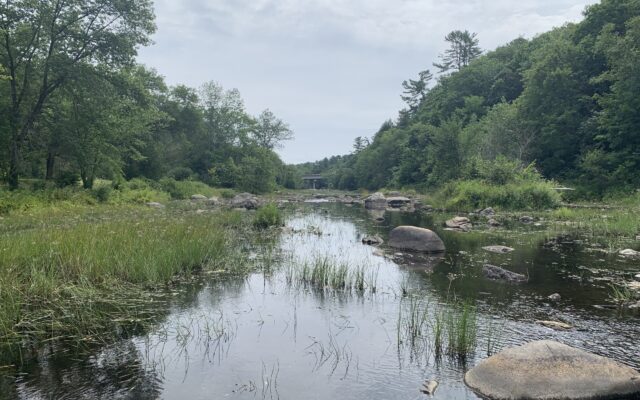
The drought is forcing Maine anglers to change where and when they fish
By Pete Warner, Bangor Daily News Staff
As drought conditions continue this summer in Maine, anglers are becoming more concerned about how the low, warm water in ponds, rivers and streams are harming the state’s fish.
So they are taking steps to help the fish survive.
Some of Maine’s most iconic waters are experiencing record-low water levels for this time of year, and avid anglers are changing where they fish — or, in some cases, not fishing at all — because even catch-and-release can stress the fish enough to kill them in these conditions. Such changes are voluntary, as the state has taken no actions to protect those waters.
“Fish are stressed by low, warm water. Often the dissolved oxygen is lower than normal as well, and fighting fish that are deprived of oxygen is not good for them,†said Bob Mallard, executive director of the Native Fish Coalition and a Bangor Daily News outdoors contributor.
Brook trout, in particular, are among the freshwater species that could struggle as temperatures rise and water levels fall.
“They survive if and where they can find cold water. But those places are smaller, and fewer, and in hot, dry summers fish have to stay in those coldwater refuge areas for longer,†said Jeff Reardon, Maine Brook Trout Project Director for Trout Unlimited.
Drought conditions this summer exist primarily in southern and coastal areas of the state. An area stretching from the midcoast down to the New Hampshire border, extending approximately 40 miles inland, is experiencing severe drought, according to the National Oceanic and Atmospheric Administration’s National Integrated Drought Information System.
Southern and eastern Maine need about 6 inches of rain over the next month to end the drought conditions.
Stream flows are mostly in the normal range across northern Maine, according to the U.S. Geological Survey’s National Water Dashboard. However, as of Tuesday, the Ducktrap River near Lincolnville and the Kennebunk River were listed as being at an “all-time low†flow rate for the date.
“St. George river, Ducktrap, all basically dry, next to no flows,†angler Ben Stendel said of the situation on the midcoast. “Trout are in hiding, but tons of smallmouth and chubs are out in both. It’s a sad state of affairs really.â€
The Sandy River near Mercer, the Narraguagus River at Cherryfield, the Sheepscot River at North Whitefield and Ellis River at South Andover were among those running at “much below normal†for the date. An additional 21 waters are listed as being “below normal†for the date.
The USGS data only includes waters that have been monitored for at least the past 30 years.
Members of Maine’s fly fishing community, in particular, are taking action to avoid subjecting fish to unnecessary stress from being targeted with hook and line.
Some avid anglers are even willing to sacrifice their pursuits to help protect the fish.
“I have only limited my wild brook trout fishing in the streams to help ensure their survival,†said Phil Polk of Princeton.
“Flows are low. I’m waiting for fall before I chase trout or salmon again,†said Stephen Monahan of Manchester.
Kris Thompson, a fly fishing guide in Rangeley, said the dry conditions are impacting his ability to take clients to streams and remote ponds.
“I normally only guide half-day trips this time of year, early or late, but water still does not always cool down enough to safely catch and release fish without killing them,†Thompson said. “I have had to turn away a few guided trips last year and this year just because I felt ethically that there were no viable options.â€
The news is better in some places, where there has been sufficient rainfall to keep the water levels at more normal levels. Aroostook is the only county in Maine that’s not considered to be experiencing any drought conditions, while it was one of the most affected counties in 2021.
“This year’s drought is no comparison to the severe drought we experienced last year when lake and river levels were extremely low,†said Gerry White, proprietor of River’s Edge Sports in Oquossoc in Franklin County. “This year levels are near normal and it has not hampered outdoor recreation, yet.â€
Central Maine resident Lucas Grotton said the bottom-flow dams on the Kennebec River in the Bingham area have helped keep the fish cool.
“This year has been better than last, that’s for sure,†Grotton said. “Water temps are a few degrees cooler than this time last year. I’m still catching salmon and brook trout in areas they were unheard of this time last year.â€
With Maine experiencing its third summer of drought conditions, some anglers have stopped waiting for the rain and altered their summer fishing practices years ago. Reardon doesn’t target trout in streams, even at high elevation, in late July and into August.
“The combination of low rainfall and long stretches of hot, sunny days and warm nights results in lower and warmer stream flows in the small headwater streams, and warmer surface water temperatures in the high elevation ponds,†Reardon said.
Mark Latti, spokesperson for the Maine Department of Inland Fisheries and Wildlife, said the agency is monitoring water conditions but isn’t likely to intervene with any emergency closures.
He said since droughts most often do not extend for more than a year or so in a particular location, biologists prefer to let nature take its course.
“A lot of people are worried about the drought, but Maine fisheries and wildlife are pretty resilient,†Latti said.
In the meantime, anglers who have experienced the ebbs and flows of water levels and temperatures are constantly evaluating how they fish for coldwater species, if they do at all.
“I’m not willing to risk killing fish I intend to release by fishing for them in warm water. I’m even less willing to target them in the spring holes where they seek refuge from the heat,†Reardon said. “These low-water, warm conditions now often extend well into September, too.â€